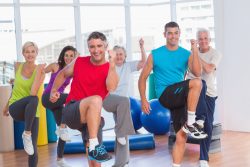 As we age, we lose muscle mass and the risk of dementia, heart disease, and immune function decreases. As the years go by, it becomes more difficult for humans to rebound from injury, a workout or illness. Aging takes a big toll on muscle tissue. Scientists have discovered that one type of activity in particular puts this process in reverse.
As we age, we lose muscle mass and the risk of dementia, heart disease, and immune function decreases. As the years go by, it becomes more difficult for humans to rebound from injury, a workout or illness. Aging takes a big toll on muscle tissue. Scientists have discovered that one type of activity in particular puts this process in reverse.
Exercise that is consistent can help slow down the process of degeneration. According to a new study on mice, aerobic exercise may have the ability to reverse aging’s effect on muscle stem cells that are essential in the involvement of tissue regeneration.
Translating the study that was done on mice to people, it means that cycling, swimming and other aerobic exercises can help the older population recover as efficiently and quickly as their once younger selves. In the future, this discovery could help contribute to the development of a drug that de-ages muscle stem cells.
Researchers have been aware for a long time that exercise does help promote lifespan which gives people extra years free from disease.
This new discovery is very different. It is somewhat like a person who has already acquired diseases through aging, reversing the process.
The research has suggested that aerobic exercise can cause cells that are old to start behaving and gaining attributes of young cells. In the study, the team used old and young mice and had them run on a wheel for 3 weeks. Using a variety of tests, they analyzed how the mouse’s stem cells and tissue that are muscle responded. They compared the mice that were running to a group that were non-exercising with a stationary wheel that was locked restricting their ability to run.
Within one week, both old and young mice with the wheels that were running were able to establish a routine. They ran about 4.9 and 10 kilometers per night, respectively.
The equivalent to humans from the mice on the running wheel would be similar to consistent aerobic exercise such as cycling, running, and swimming, but no weight lifting or strength training involved.
At the end of the three week period of voluntary running on the wheel, the mice were then relocated to cages that didn’t have wheels. Then, the team injured various muscles and than looked at whether the mice could rebuild the tissue that was injured.
They additionally transplanted muscle stem cells from older mice into the injured mice and observed if the cells functioned well. Compared to young donor muscle stem cells, old donor muscle stem cells formed fewer and smaller fibers in the mice that were injured. However, old muscle stem cells from mice that exercised performed much like young muscle stem cells and formed many fibers than old muscle stem cells and were non-exercising.
Overall, the older mice that were allowed to exercise experienced accelerated repair of muscle tissue and improvement of the function of the muscle stem cells.
The older mice that were active did not produce more stem cells that are muscle. Instead, exercising had a rejuvenating effect on the old cells. The team noted it helped the mice operate more like their once younger selves.
The benefits did disappear after one week after the mice were put in cages without wheels which suggests that the rejuvenating effect is consistent exercise. This indicates that voluntary aerobic exercise may have benefits that are above and beyond preventing age related diseases and may really improve function of tissue directly.
The idea is that the older humans would recover more efficiently and faster just like younger humans do as a response to injury.
The team notes that surprisingly the younger mice who ran on the wheel did not experience muscle repair that was improved. This puzzled the team. Its seems young mice have already plateaued. They will lose function with age and they can get back to that baseline, but it is hard to get them better with more exercise.
The effects of exercise on stem cells that are muscle and repair of tissue is dependent on a tiny protein known as cyclin D1. Voluntary aerobic exercise was able to restore cyclin D1 levels in stem cells that were dormant back to a more youthful state.
Discovering cyclin D1’s crucial role means scientists might be able to target the protein therapeutically or even develop a new drug with the ability to create these positive de-aging effects. However, before any prescribed exercise routine or anti-aging pill can be verified, research on humans needs to be done.
To view the original scientific study click below:
Exercise rejuvenates quiescent skeletal muscle stem cells in old mice through restoration of Cyclin D1





